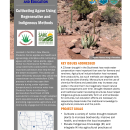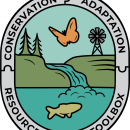Location
States
New MexicoEcosystem
DesertIntroduction
Chelenzo Farms, located twenty miles south of the city of Santa Fe, New Mexico, is a regenerative farm that applies permaculture, soil health, and agroecology principles. It has three operating principles of research, education, and community. It practices dryland farming, focusing on the cultivation of agave and native plants.
With over 200 varieties, agave can be distilled to make liquor, fermented for livestock feed, and made into textiles. In fact, 75% of those varieties have been cultivated in Mexico for thousands of years. Thus, agaves have long supported a variety of pollinators in the Southwest and along the border with Mexico in the Chihuahuan and Sonoran deserts, with the best known one being the endangered Mexican long-nosed bat (Leptonycteris nivalis). Hawkmoths, hummingbirds, bees, wasps, and other insects also pollinate agave.
Agaves are able to use water efficiently because they utilize the crassulacean acid metabolism (CAM) process, an alternate form of photosynthesis. CAM succulents open their stomata during cooler nighttime temperatures to minimize water loss and have evolved to store rainwater during the summer monsoon season and conserve it throughout the year. These drought-resistant plants can help agricultural producers in the Southwest become more resilient to climate change climate change
Climate change includes both global warming driven by human-induced emissions of greenhouse gases and the resulting large-scale shifts in weather patterns. Though there have been previous periods of climatic change, since the mid-20th century humans have had an unprecedented impact on Earth's climate system and caused change on a global scale.
Learn more about climate change .
Chelenzo Farms is growing a number of CAM succulents including agave, cholla, cacti, yucca, and desert spoon along with other native plants to increase drought-adapted plant populations. Their regenerative agriculture practices improve soil health, boost plant diversity, and restore pollinator populations while conserving water resources. In line with its permaculture and organic practices, the farm does not apply chemical herbicide or fertilizers. The farm has implemented a number of innovative water conservation practices including creating Indigenous-inspired water-harvesting earthworks and the cultivation of drought-resistant plants that support its focus on dryland farming. Chelenzo Farms also plays an active role in the community by hosting workshops and supporting other local farmers. The farm’s owners hope to showcase a sustainable production system and increase appreciation for native plants and ecosystems.
Key Issues Addressed
A 23-year drought has made water conservation more important than ever in New Mexico. Warmer temperatures lead to water shortages, threatening water-intensive crops. Situated at nearly 6,000 feet in the middle of a desert, water is especially scarce at Chelenzo Farms.
Agricultural industrialization may have increased farm productivity, but these techniques can degrade soils and reduce plant diversity. Monoculture, the practice of planting single crops, and the use of synthetic inputs like chemical fertilizers and pesticides may increase crop yields in the short term, but negatively impact natural soil microorganisms that help maintain soil health and retain water over time.
Additionally, monoculture reduces the diversity of flowering plants like agave that wildlife, especially pollinators, depend on. Agaves are monocarpic, meaning they only flower once before dying. Typically, farmers cut the center stalk of the agave, called the quiote in Mexico, before it can flower, resulting in a larger heart, or piña, that can be used for goods. However, this practice reduces the number of flowering agave available to support pollinators.
As temperatures increase and water resources decline, the integration of Indigenous techniques and knowledge can make contemporary farming practices more sustainable. In addition to holding cultural significance for Indigenous groups, many native plants, including agave, are highly resistant to drought. Drought-resistant plants and traditional water harvesting structures, such as Zuni bowls and one-rock dams, have helped Indigenous groups sustainably farm arid landscapes for centuries. Education efforts are necessary to promote sustainable production systems and responsibly disseminate traditional knowledge to producers and the public.
Project Goals
- Cultivate a variety of native drought-resistant plants using regenerative and sustainable practices to increase biodiversity, improve soil health, and restore the local ecosystem
- Elevate Indigenous Knowledge (IK) and integrate IK into agricultural practices at Chelenzo Farms
- Establish relationships with producers to educate them on native plants, IK, and the value of sustainable production systems to enhance their resilience to climate change
Project Highlights
Value of Networking: The owners of Chelenzo Farms value a mutual exchange of information and have established relationships across agricultural, cultural, and artistic disciplines.
- Regenerative Methods: Chelenzo Farms grows a variety of slow-growing, drought-resistant plants, such as agave, cacti, cholla, yucca, and desert spoon and is committed to allowing at least half of agave plants to flower to support pollinators. Rather than applying chemical fertilizer, they use natural amendments such as inoculants to supplement soil nutrients and promote plant growth. The farm composts a mixture of organic produce, horse and chicken manure, goat bedding, and hay using Johnson-Su bioreactors—cylindrical, stack-like structures—to make soil that is rich in fungi, bacteria, and other microorganisms. Workers pour half a cup of a mixture of one part Johnson-Su compost to nine parts water into each hole before planting succulents.
- Community Engagement and Education: The farm hosts educational workshops to teach regenerative farming practices to producers and the public. Past workshops have taught the creation of water harvesting earthworks, building of Johnson-Su bioreactors, and the basics of cultivating soil health. At the Agave Planting Party in June 2023, volunteers planted 460 succulents, including 300 agaves, and learned more about succulents and the use of inoculants. Cruces Creatives, a non-profit makerspace in nearby Las Cruces that supports regenerative agriculture initiatives, provided lunch, and the New Mexico Department of Agriculture and USDA contributed to the funding for the event. The event was an opportunity to showcase the Indigenous practice of working the land as a community.
- Indigenous Agriculture as Art: In honor of the 50th Anniversary of the Endangered Species Act, the Endangered Species Coalition helped sponsor the creation of two murals at the farm. One mural, titled Mayáhuel, depicts the Aztec goddess of agave surrounded by Mexican long-nosed bats, important pollinators of agave. The other features Mictlantecuhtli, the Aztec god of death, and two endangered species, the Mexican wolf (Canis lupus baileyi) and the Mexican spotted owl (Strix occidentalis lucida). The addition of these murals is symbolic of what Chelenzo Farms hopes to achieve: a regreening of the landscape by pairing soil science with the art of Indigenous agriculture.
Lessons Learned
The use of natural amendments is an evolving practice having numerous application strategies and mixtures. Inoculation at the time of planting is most important, but follow-up applications, typically done once per year, can be beneficial. The Johnson-Su composting method incorporates materials commonly available on farms and allows complex fungal biomass to develop during the 12-18 month process. Commercial inoculants are also available and can be helpful for achieving an appropriate ratio of fungal to bacteria biomass.
Volunteer partnerships are critical to the success of the farm. Chelenzo Farms utilizes both workshop volunteers as well as Worldwide Opportunities on Organic Farms (WWOOF) volunteers—called WWOOFers—to complete projects and daily operations. WWOOFers work for about 25 hours per week in exchange for meals and lodging, and they learn regenerative agriculture and organic farming principles throughout their stay.
Grants are a valuable source of funding for regenerative agriculture projects. For example, a Western SARE (Sustainable Agriculture Research and Education) grant partially funded the Agave Planting Party in June 2023 and will enable Chelenzo Farms to develop a permaculture food forest, construct water harvesting structures, and educate other producers by participating in conferences and hosting a radio talk show. Western SARE grants support sustainable agriculture projects that conduct both research and outreach and are open to farmers, ranchers, and research scientists.
While grants are an excellent opportunity for producers, the application process can be challenging and time-intensive. Applications must include a detailed description of what will be done during the project, the intended outcomes, and supporting research.
Fortunately, there are technical assistance programs, including tutorials, webinars, and workshops, designed to help producers through the grant writing process. The Grant Writing Tutorials & Webinars webpage on the Western SARE website has several resources specific to Western SARE grants. The National Institute of Food and Agriculture provides an overview of the grant lifecycle, database containing funding opportunities, and guidelines for managing grants on its Grants Page.
Next Steps
- Work with New Mexico State University’s Agricultural Science Center to implement semicircular buffer strips in a new field containing various CAM succulents, including agave, cacti, cholla, and yucca. Buffer strips placed between the rows of crops will serve as wind barriers, decreasing water consumption and soil erosion.
- Construct Zuni bowls, one-rock dams, and a retention pond to improve water management on the farm.
- Continue planting a variety of succulents and developing a permaculture food forest.
Funding Partners
- Western SARE Farmer/Rancher Research & Education Competitive Grant
- New Mexico Department of Agriculture
- Endangered Species Coalition
Resources
- Cummins R. (2020). “Agave Power: Greening the Desert.” Regeneration International.
- Davis et al. (2021). “Expanded Potential Growing Region and Yield Increase for Agave americana with Future Climate.” Agronomy.
- Ebeling et al. (2008). “How does plant richness affect pollinator richness and temporal stability of flower visits?” Oikos 117(12): 1808.
- Sagar et al. (2022). “Bioinoculants—Natural Biological Resources for Sustainable Plant Production.” Microorganisms 10(1): 51.
- Stewart J. R. (2015). “Agave as a model CAM crop system for a warming and drying world.” Frontiers in Plant Science 6: 684.
- Nabhan et al. (2022). “Comparing Wild and Cultivated Food Plant Richness Between the Arid American and the Mesoamerican Centers of Diversity, as Means to Advance Indigenous Food Sovereignty in the Face of Climate Change.” Frontiers in Sustainable Food Systems 6.
- Additional Resources:
Contacts
Lorenzo Dominguez, Chelenzo Farms: lorenzo@haciendadominguez.com
CART Lead Author
Jack Carter, CART Student Writer, University of Oklahoma
Suggested Citation
Carter, J., B. (2023). “Cultivating Agave Using Regenerative and Indigenous Methods.” CART. Retrieved from https://www.fws.gov/project/cultivating-agave-regenerative-and-indigenous-methods.






